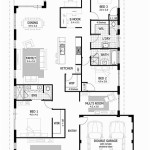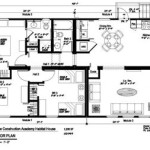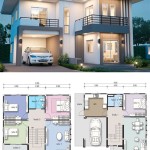One Bedroom Floor Plan With Dimensions In Meters
A one-bedroom floor plan with dimensions in meters is a technical drawing that illustrates the layout of a single-bedroom apartment or house, specifying the size of each room and overall space using the metric system. These plans are essential for architectural design, interior decorating, furniture planning, and real estate marketing. The precision afforded by using meters allows for accurate space calculations, ensuring compatibility between furniture and the available area. Understanding these plans is crucial for renters, buyers, designers, and contractors alike.
The primary function of a one-bedroom floor plan is to provide a scaled representation of the living space. This representation includes the bedroom, living room, kitchen, bathroom, and any additional spaces such as balconies, closets, or hallways. The dimensions, expressed in meters and potentially with decimals for greater accuracy, indicate the length, width, and height of each area, as well as the positioning of doors, windows, and built-in features. These dimensions enable individuals to understand the spatial relationships between different parts of the dwelling and to visualize how the space will function in practice.
Floor plans typically include several key elements. Walls are represented by solid lines, with their thickness indicating the actual wall thickness. Doors are shown as arcs that indicate the direction of the door swing. Windows are depicted as gaps in the walls. Fixtures such as sinks, toilets, bathtubs, and appliances in the kitchen are also drawn to scale. Dimensions are indicated by lines with arrowheads at both ends and the numerical value representing the measurement placed above or alongside the line. Additionally, legends or keys frequently accompany the plans, explaining the symbols and abbreviations used.
The scale of the floor plan is critical for accurate interpretation. Common scales used in architectural drawings include 1:50, 1:100, and 1:200. A scale of 1:100 means that 1 centimeter on the drawing represents 1 meter in reality. Understanding the scale allows users to convert measurements from the drawing to actual dimensions and vice versa. For example, if a wall measures 4 centimeters on a drawing with a scale of 1:100, the actual length of the wall is 4 meters.
The process of creating a one-bedroom floor plan typically involves the use of Computer-Aided Design (CAD) software. CAD software allows architects and designers to create precise and detailed drawings, including the accurate representation of walls, doors, windows, and fixtures. It also simplifies the process of adding dimensions and annotations. Hand-drawn floor plans are also possible, but they require a high level of drafting skill and attention to detail.
Different types of one-bedroom floor plans exist, each tailored to specific spatial configurations and design preferences. Linear layouts feature rooms arranged in a straight line, often found in older buildings or apartments with narrow dimensions. Open-concept plans combine the living room, dining area, and kitchen into a single large space, creating a greater sense of spaciousness. L-shaped floor plans position the bedroom and bathroom on one side of the living area, providing a degree of separation between the living and sleeping spaces. Each layout has its advantages and disadvantages, depending on the individual's needs and lifestyle.
When reviewing a one-bedroom floor plan with dimensions in meters, several factors should be considered. The overall size of the apartment is a primary consideration, as this will dictate the amount of available living space. The size and layout of the bedroom are also important, as this determines the suitability for furniture placement and personal comfort. The dimensions of the living room should be assessed to ensure it can accommodate seating, entertainment systems, and potentially a dining area. The kitchen layout and dimensions are crucial for efficient cooking and storage. Finally, the size and location of the bathroom should be considered, along with the placement of closets and storage spaces.
The use of metric dimensions offers several advantages over the imperial system. The metric system is based on units of ten, which simplifies calculations and conversions. Meters are a convenient unit for measuring room sizes and distances, providing a more intuitive understanding of space than inches or feet. The metric system is also the standard system used in most countries around the world, facilitating communication and collaboration among architects, designers, and contractors globally.
Floor plans are essential for space planning. By accurately representing the dimensions of each room, these plans enable individuals to experiment with different furniture arrangements and layouts before physically moving items. This can save time and effort, as well as prevent damage to furniture or the apartment itself. Space-planning software or online tools can be used in conjunction with the floor plan to visualize different design options in 3D.
Key Points of a One-Bedroom Floor Plan
A floor plan is not simply a drawing; it’s a crucial tool for designing, understanding, and manipulating space. Here are some key elements to consider when working with one-bedroom floor plans measured in meters:
Understanding Spatial Relationships
The floor plan clearly illustrates the relationships between different rooms and zones within the one-bedroom apartment. The dimensions provided in meters allow one to understand the size, shape, and adjacency of the spaces. For example, the distance between the kitchen and the living room can be easily determined, informing choices about traffic flow and furniture placement. Examining the proximity of the bedroom to the bathroom can highlight advantages (convenience) or disadvantages (potential noise issues). The plan's emphasis lies not just in individual room sizes but in how these areas interact, helping visualise the living experience.
The placement of doorways and hallways significantly influences the spatial relationship between rooms. A narrow hallway may restrict the movement of furniture and people, while a wide doorway can create a more open and inviting transition. The orientation of the rooms in relation to each other can also affect the overall feeling of the space. For example, a south-facing living room may receive more natural light than a north-facing bedroom. Understanding these spatial relationships is essential for optimizing the functionality and aesthetics of the apartment.
The arrangement of built-in features, such as closets, cabinets, and shelves, also contributes to the spatial organization. Closets strategically placed near the bedroom or entryway can provide convenient storage solutions. Built-in bookshelves or entertainment centers can integrate seamlessly into the living room design. Analyzing the placement and dimensions of these features allows one to assess their usability and potential impact on the overall layout.
Accurate Furniture Placement and Space Optimization
Detailed floor plans with metric dimensions are immensely valuable for planning furniture layouts. Knowing the exact dimensions of the living room, for example, allows one to determine whether a sofa, coffee table, and entertainment unit can comfortably fit within the space. The dimensions of the bedroom help in selecting an appropriately sized bed, nightstands, and dresser. Being armed with measurements enables furniture placement without guesswork or costly mistakes. It becomes possible to experiment with different arrangements on the floor plan, ensuring optimal flow and usability within the apartment.
The floor plan can also highlight potential areas for space optimization. Identifying unused corners or awkward spaces can inspire creative storage solutions, such as corner shelves or custom-built cabinets. The dimensions of the closets can be used to plan the organization of clothing and accessories, maximizing the available storage capacity. Careful consideration of the floor plan allows one to make the most of every square meter of the apartment, creating a functional and comfortable living environment.
Consideration should be given to vertical space as well. The height specified on the plan, though less common, can affect choices regarding tall bookshelves or floor-to-ceiling storage units. By understanding the vertical dimensions in conjunction with the floor plan, one can fully utilize the available space and create a well-proportioned and aesthetically pleasing interior.
Communicating Design Intent
Clear and accurate floor plans serve as a universal language when collaborating with contractors, interior designers, and landlords. Providing a detailed floor plan with metric dimensions eliminates ambiguity and ensures that everyone is on the same page regarding the proposed layout and design. The floor plan serves as a visual reference, facilitating communication and preventing misunderstandings. This is particularly important when making renovations or modifications to the apartment, as the floor plan provides a clear roadmap for the project.
The floor plan can also be used to obtain accurate cost estimates for materials and labor. Contractors can use the dimensions to calculate the amount of flooring, paint, or other materials needed for the project. Interior designers can use the floor plan to develop detailed furniture plans and provide accurate quotes for their services. By providing a clear and comprehensive floor plan, one can ensure that the project stays on budget and is completed to the desired specifications.
Furthermore, a well-prepared floor plan is an invaluable tool for marketing the apartment to potential renters or buyers. A visually appealing and informative floor plan can showcase the layout, dimensions, and key features of the property, attracting more attention and increasing the likelihood of a successful transaction. Including the dimensions in meters adds a level of professionalism and precision that can instill confidence in potential occupants. A detailed floor plan can be a key differentiator in a competitive real estate market.

Small House Plan 7x6 Meters 1 Bed Hip Roof Ground Floor

One Bedroom House Plans 21x21 Feet 6 5x6 5m Tiny

One Bedroom House Plans Peggy

30x26 House 1 Bedroom Bath 780 Sq Ft Floor Plan Instant Model 3b

Cottage Style House Plan 3190 The Bunting

One Bedroom Chalet With Kitchenette 1489

One Bedroom Small House Plan 6x7 Meter 42 Sqm Samhouseplans

One Bedroom House Plans 6x6 With Shed Roof Samhouseplans

House Plan 1 Bedrooms Bathrooms 1902 Drummond Plans

Beautiful 1 Bedroom Bungalow Floor Plan Sample
Related Posts








